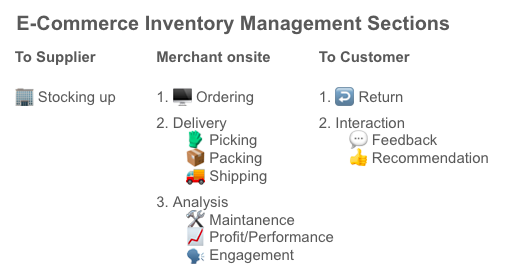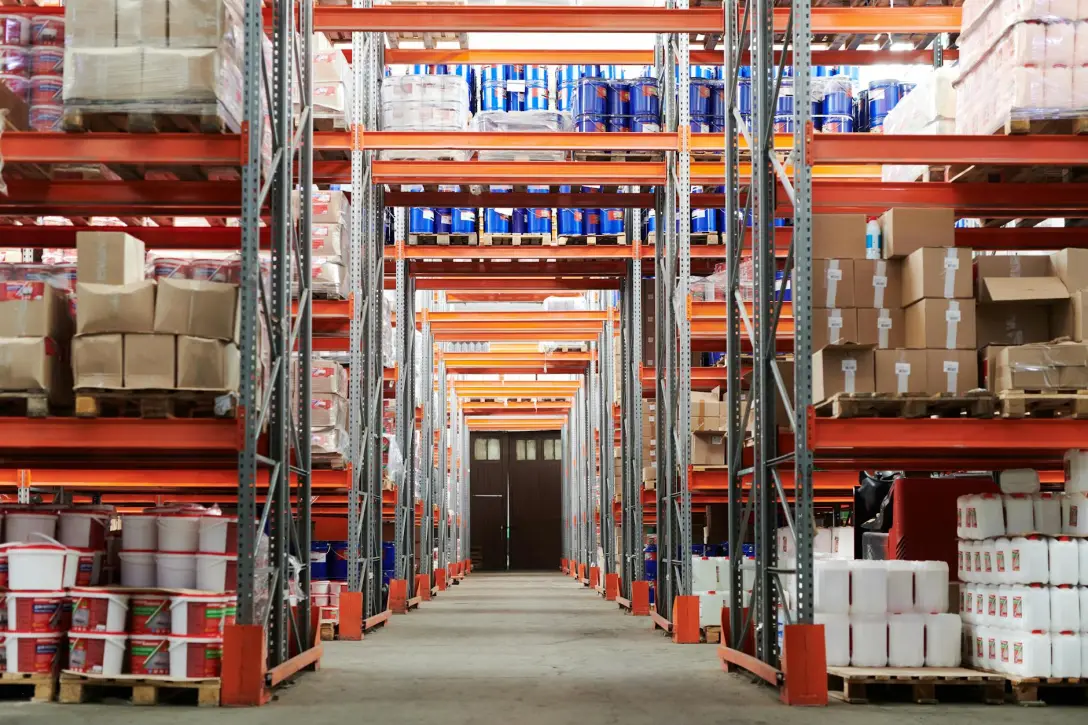When I reviewed the IOT applications in E-Commerce Inventory Management, I feel frustrated about there are too many potentials and I got lost in these applications. I think it’s better to have a more organize approach to group the applications into the inventory management sections.
IOT, aka Internet of Things, is a bridge between physical and digital worlds. IOT allows people to connect with the digital world in tangible channels, when the web allows customer and supplier interacting with each other. IOT can collect data from the customers, and merchants can use these data to provide better service. Thus, the data analysis is the best and important approach to apply IOT technology in inventory management.
Inventory management is a key component to make the business run smoothly when an E-Commerce business scales up. If we just rely on manual processes, it’s easy to cause mispicks and misships [1] and lose our customers. In this article, we separate the inventory management into 3 sections based on merchant perspective: to supplier, merchant onsite, and to customer. We will discuss how IOT can apply into the components in these sections.

To Supplier
Receiving and Restocking
When goods are delivered to the inventory, we can track the inventory level. Via RFID tags and sensors, we can restock when low level and not overstock when high level to avoid stockouts and overstock situations [4]. In quality perspective, we can monitor the product availability, the expiration date, and the type of product [6]. This can reduce the unnecessary storage space and manufacturing cost and the waste for perishable goods [3].
Merchant Onsite
1. Ordering online
Through IOT sensor data, E-Commerce sites can respond to customer in realtime. For UIUX, the E-Commerce site can provide more mobile-friendly solutions [7]. With the user browsing and purchase history, merchant can provide recommendation contents [4]. Via access the shopping cart, wish list, and customer profile, merchant can provide personalized approaches [5]. These strategies are relied on IOT devices collecting the customer information.
2. Delivery
IOT technology can build a smart warehouse and create robots to automate the routine operations, including delivery, payment, and restocking etc. [3][7][5]
a. Picking
IOT makes the shopping procedures more automatic and accurate way. Automatic picking system [4] and predictive system [7] reduce the manual error and even prepare the available items ahead.
b. Packing
As the last step in inventory, IOT may ensure the product quality and customer fulfillment. IOT application with QR codes or NFC tags may provide additional product information to fulfill customer needs. With IOT quality control monitoring, customer can trust the freshness and condition of the perishable product [4].
c. Shipping
Thankful to the IOT GPS and RFID feature, location and status tracking is an important application on E-Commerce logistics. IOT device collected traffic, weather, and employee information can optimize the logistics delivery routes [7][6]. The accurate delivery can avoid wrong shipment and unnecessary shipping cost [6]. With the web realtime feature, merchant can send notification and update of the order [4] and this transparent up-to-date information can earn customer satisfaction [4][3].
3. Analysis
Troubleshooting and performance analysis are the the important implementations for IOT technology in E-Commerce business.
a. Issue detection
IOT sensor on inventory equipment and machinery can remotely monitor the performance and predict the maintenance [6][4]. This may avoid the downtime and reduce the repair cost. Other problems, such as missing shipments and cart abandonment, are also able to be caught with IOT technology [6][3].
b . Profit
Using IOT to monitor the inflow and outflow of products, driving path, and customer locations can help merchants to analyze if they meet KPIs [3][6]. Via analyzing IOT data, merchants can align strategies with the market to improve ROI (return on investment) and find patterns and opportunities [4][7].
c. Customer Engagement
IOT devices or IOT-enabled products allows merchants to collect usage data, customer behavior, preferences, and purchase patterns, and it lets merchant to provide more personalized customer engagement in a seamless connection [5][4]. In larger scale, we can collect a group’s data [3], geolocation based data [4], social media data [6] to have the insight of the group to provide specific recommendations.
To Customer
1. Return
IOT technology can help merchants to identify the usable goods. These products can be returned to stock inventory or resold on the market, and it reduces the waste and remanufacturing cost [8]. IOT can also establish an automated return system to handle the return requests [4].
2. Interaction
a. Feedback
IOT devices can collect users’ feedback and review in real-time. This information allows merchants to know the customer satisfaction and how to improve the product [4]. This is an interaction between customer and manufacturer to work out the better product [7][6]. Another application is IOT-powered chatbot lets users have interaction channel for problem solving and responsive communication [4].
b. Recommendation
As the above Customer Engagement section discussed, IOT technology can collect customer data and merchant can use this data to understand more about the customer and provide better recommendation promotion [4].
Summary
IOT technology gives E-Commerce business a valuable tool to watch whole automatic system and be able to respond in realtime. From the product arriving inventory to delivered to customer, IOT technology collects the data in inventory, on customer ordering history, and to order delivery. This data is about the product itself, the e-commerce inventory system, and customer’s feedback. The IOT data in inventory management gives business chances to notify the issues, analyze the performance, and improve product and customer engagement. With the IOT applications in E-Commerce inventory management, the merchants can have a better sense of how the business is operating, product is delivering, and customer is feeling.
References
- [1] What is a fulfillment center and why is it important? https://www.bigcommerce.com/glossary/fulfillment-center/
- [2] Inventory Management Techniques Every Online Business Needs to Know https://www.bigcommerce.com/articles/ecommerce/inventory-management/
- [3] How to Boost Revenue Growth with eCommerce IoT https://anywhere.epam.com/business/internet-of-things-in-e-commerce-iot
- [4] IOT IN ECOMMERCE AND RETAIL: YOUR HANDBOOK FOR ELEVATING THE SHOPPING JOURNEY https://intexsoft.com/blog/iot-in-ecommerce-and-retail/
- [5] The Surreal and Bigger Influence of IoT on the Future of E-Commerce https://readwrite.com/the-surreal-and-bigger-influence-of-iot-on-the-future-of-e-commerce/
- [6] 10 Innovative Uses of Internet of Things in E-commerce https://coruzant.com/iot/10-innovative-uses-of-internet-of-things-in-e-commerce/
- [7] How the Internet of Things (IoT) Can Help Your Ecommerce Business https://www.iotforall.com/ways-the-internet-of-things-iot-can-help-your-ecommerce-business
- [8] Success in managing complexity: the role of the Internet of Things in creating a circular economy https://www.ellenmacarthurfoundation.org/tech-enablers-series/part-3
